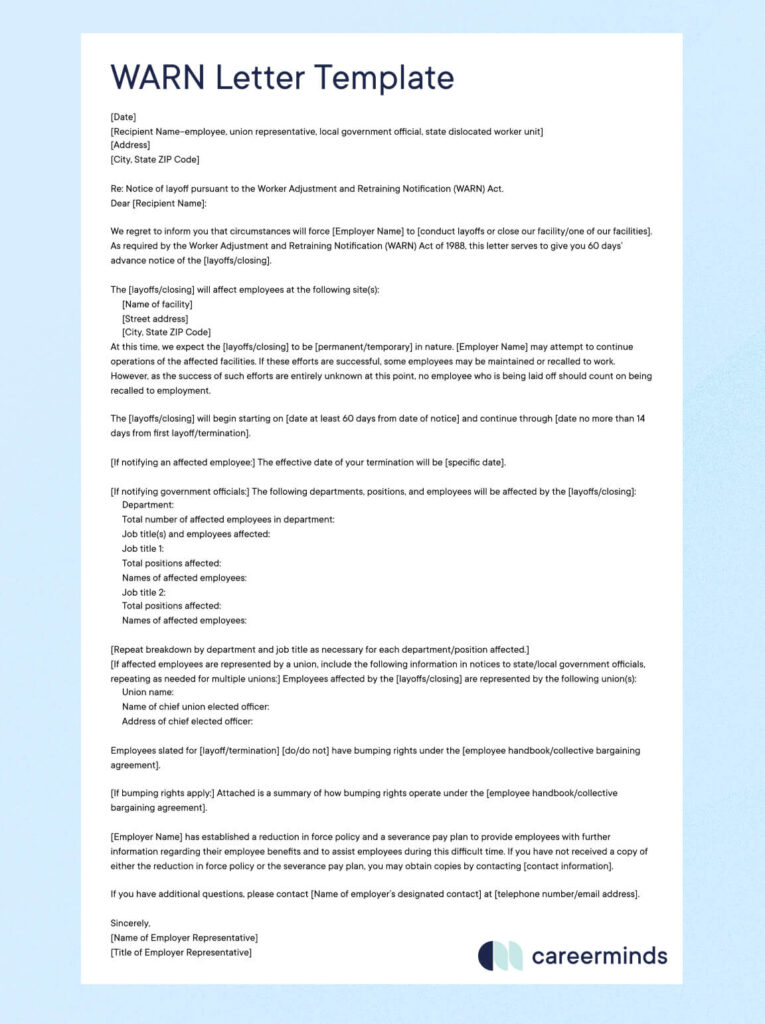
Preparing for a RIF?
Download our Essential Guide to Handling a Layoff
Request Pricing
Compare our rates to other providers
If your organization is going through a layoff or reduction in force (RIF), you’re probably trying to figure out whether or not you need to abide by The Worker Adjustment and Retraining Notification Act (or WARN Act). If you do qualify, you will need a WARN letter example to craft the required employee notifications for your reduction event.
In this blog, we will share a sample WARN letter example and go over what to include in your own WARN letter. We will also cover how to tell if your reduction event qualifies under the WARN Act and how to deliver your letter to comply.
What Is an Example of a WARN Letter?
Let’s start with a sample WARN letter example to give you an idea of what your WARN letter should entail. Below is a template of a WARN letter example that you can copy and customize for your own WARN notification needs.
| COPYABLE EXAMPLE:
[Date] [Recipient Name–employee, union representative, local government official, state dislocated worker unit] [Address] [City, State ZIP Code] Re: Notice of layoff pursuant to the Worker Adjustment and Retraining Notification (WARN) Act. Dear [Recipient Name]: We regret to inform you that circumstances will force [Employer Name] to [conduct layoffs or close our facility/one of our facilities]. As required by the Worker Adjustment and Retraining Notification (WARN) Act of 1988, this letter serves to give you 60 days’ advance notice of the [layoffs/closing]. The [layoffs/closing] will affect employees at the following site(s): [Name of facility] [Street address] [City, State ZIP Code] At this time, we expect the [layoffs/closing] to be [permanent/temporary] in nature. [Employer Name] may attempt to continue operations of the affected facilities. If these efforts are successful, some employees may be maintained or recalled to work. However, as the success of such efforts are entirely unknown at this point, no employee who is being laid off should count on being recalled to employment. The [layoffs/closing] will begin starting on [date at least 60 days from date of notice] and continue through [date no more than 14 days from first layoff/termination]. [If notifying an affected employee:] The effective date of your termination will be [specific date]. [If notifying government officials:] The following departments, positions, and employees will be affected by the [layoffs/closing]: Department: Total number of affected employees in department: Job title(s) and employees affected: Job title 1: Total positions affected: Names of affected employees: Job title 2: Total positions affected: Names of affected employees: [Repeat breakdown by department and job title as necessary for each department/position affected.] [If affected employees are represented by a union, include the following information in notices to state/local government officials, repeating as needed for multiple unions:] Employees affected by the [layoffs/closing] are represented by the following union(s): Union name: Name of chief union elected officer: Address of chief elected officer: Employees slated for [layoff/termination] [do/do not] have bumping rights under the [employee handbook/collective bargaining agreement]. [If bumping rights apply:] Attached is a summary of how bumping rights operate under the [employee handbook/collective bargaining agreement]. [Employer Name] has established a reduction in force policy and a severance pay plan to provide employees with further information regarding their employee benefits and to assist employees during this difficult time. If you have not received a copy of either the reduction in force policy or the severance pay plan, you may obtain copies by contacting [contact information]. If you have additional questions, please contact [Name of employer’s designated contact] at [telephone number/email address]. Sincerely, [Name of Employer Representative] [Title of Employer Representative] |
Feel free to copy and customize this sample letter above to craft your own WARN letter example. Of course, remember to consult with your legal counsel to ensure you are including all necessary language and complying with all local, state, and federal WARN laws. You can also download our full WARN Act checklist below to help get you started with what WARN letter notifications you will need.
What Format Is Required for a WARN Notice?
Now let’s break down this sample WARN letter example to understand its key components. When you begin to draft your own WARN letter example for employees, you’ll need to include five key sections in the letter, as seen in our sample WARN letter example above.
These five key sections are:
- A statement about whether the layoff will be permanent or if employees will be called back.
- When the reduction event will start and when that specific employee is likely to be let go.
- Your organization’s policy on bumping rights.
- A list of severance benefits that your organization will provide when laying off.
- Contact information if the employee has further questions.
Let’s take a deeper dive into each of these sections to help you craft your own version of the sample WARN letter example above.
WARN Letter Example: Section 1
In this first section, you will need to let your employees know whether you are holding a permanent reduction in force (RIF) or a temporary layoff. You will want to explain why you have made that certain choice, such as the rationale for why some employees are being permanently let go while other employees are being temporarily laid off.
If a temporary layoff, you will also want to lay out your employee recall policy and processes. Whatever the situation, you will want to clearly explain what this reduction event will entail and how permanent it will be.
WARN Letter Example: Section 2
In this section, you will need to go over the specific logistics of when, how, and where an employee will be let go. Ideally, this means including a timeline of when the reduction event will start, when meetings will take place, and how much time impacted employees will have to ask questions and find new work.
If you aren’t yet sure of this information, try as much as possible to narrow in on something quantitative to tell your employees, such as a range of dates. This will help your employees prepare for their job search if they are being permanently reduced, or figure out their finances if they will be temporarily laid off.
WARN Letter Example: Section 3
Several organizations have policies around bumping rights. Bumping rights are the right of an employee to bump off one of their lower level employees in order to keep their own job at an organization during a reduction event.
For example, if you are laying off your line manager, he could instead bump out one of his line employees and keep his own job at the organization. He would have to assume that lower level position, and likewise receive lower pay, but he would still have a position at the organization.
So in this section, make sure to describe what bumping rights your employees have and how they would need to execute them.
WARN Letter Example: Section 4
In this section, it’s important to list what severance benefits your organization will offer to impacted employees. These benefits will probably be different based on whether your employees are being temporarily laid off or permanently let go.
For example, employees who are being temporarily laid off will likely need information about the continuation of their health and financial benefits, while permanently laid off employees will need information about severance pay and outplacement services.
WARN Letter Example: Section 5
This final section is the simplest one. You will simply need to include contact information for someone in Human Resources at your organization who is available to answer any questions that your employees might have about this WARN letter.
When Do You Need a WARN Letter?
The WARN Act has several regulations that dictate who the law should be applied to in the United States. This includes the following stipulations:
- The WARN Act applies to organizations that have over 100 full-time employees.
- The WARN Act applies to publicly and privately held companies.
- The WARN Act applies to organizations that are for-profit or not-for-profit.
- A WARN notice must be given if there is a plant closing or a mass layoff.
We have additional resources to help you understand these WARN Act stipulations, including the federal definitions of a “plant closing” and “mass layoff,” as well as any additional stipulations that might apply in specific situations, such as “extended layoffs” or other types of “employment loss.”
Also keep in mind that some states have their own, more stringent state-level WARN Act regulations, such as California, Illinois, New Jersey, and New York. Make sure to consult with your corporate counsel to identify all of the applicable local, state, and federal laws that could impact your business.
How to Comply with Your WARN Letter?
If you do qualify under the above stipulations, you will need to comply with the WARN Act regulations. Let’s break down what this will mean for your organization and what you will need to do with your WARN letter example.
To comply with the WARN Act, you will need to let your affected employees know 60 days in advance of their last day with the organization. This can be done through several different delivery methods, as long as it is given in writing and not included with other pre-printed notices that are already regularly included with employees’ paychecks.
Your organization must also provide a notice to your government about your reduction event. Similar to the notice given to your employees, this notice must also be delivered at least 60 days in advance to the State Rapid Response Dislocated Worker Unit, as well as to the chief elected official of the local government where the closing or mass layoff is to occur.
The sample WARN letter example shared above can be customized in order to notify your impacted employees as well as your local government officials. As always, be sure to consult your legal counsel as you modify the sample with your organization’s information and reduction event specifics, and then send it out in the required timeframe to comply with the WARN Act.
At Careerminds, we believe that you can never be too prepared for your next reduction event. Our arsenal of layoff resources, templates, guides, and industry-leading outplacement services can help you navigate the delicate layoff process. Click below to speak with one of our experts and see if we are the right partner for your organization.
In need of outplacement assistance?
At Careerminds, we care about people first. That’s why we offer personalized talent management solutions for every level at lower costs, globally.




